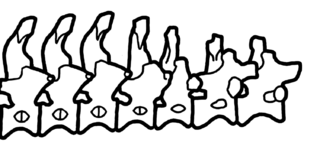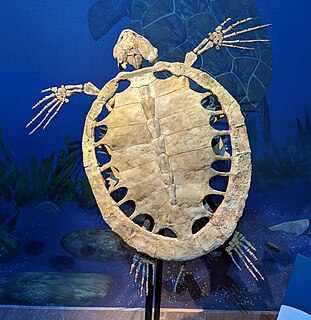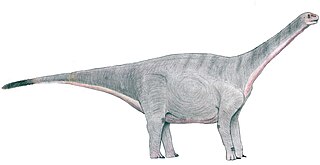
Dinheirosaurus is a genus of diplodocid sauropod dinosaur that is known from fossils uncovered in modern-day Portugal. It may represent a species of Supersaurus. The only species is Dinheirosaurus lourinhanensis, first described by José Bonaparte and Octávio Mateus in 1999 for vertebrae and some other material from the Lourinhã Formation. Although the precise age of the formation is not known, it can be dated around the early Tithonian of the Late Jurassic.

Lusotitan is a genus of herbivorous brachiosaurid sauropod dinosaur from the Late Jurassic Period of Portugal.

Lampetra is a genus of lampreys in the subfamily Petromyzontinae.

Tupandactylus is a genus of tapejarid pterodactyloid pterosaur from the Early Cretaceous Crato Formation of Brazil.

Euclastes is an extinct genus of sea turtles that survived the Cretaceous–Paleogene mass extinction. The genus was first named by Edward Drinker Cope in 1867, and contains three species. E. hutchisoni, was named in 2003 but has since been reassigned to the genus Pacifichelys, while E. coahuilaensis named in 2009 was reassigned as Mexichelys coahuilaensis in 2010.
Chaudoirina is a genus of beetles in the family Carabidae, containing the following species:

Philorhizus is a genus of beetles in the family Carabidae, containing the following species:
Anillotarsus is a genus of ground beetles in the family Carabidae. This genus has a single species, Anillotarsus tetramerus.
Cryptocharidius is a genus of ground beetles in the family Carabidae. This genus has a single species, Cryptocharidius mandibularis.
Perucharidius is a genus of ground beetles in the family Carabidae. There are at least two described species in Perucharidius, found in Peru.
Oxytrechus is a genus of beetles in the family Carabidae, containing the following species:
Pseudocnides is a genus of beetles in the family Carabidae, containing the following species:

Kaatedocus is a genus of diplodocine flagellicaudatan sauropod known from the middle Late Jurassic of northern Wyoming, United States. It is known from well-preserved skull and cervical vertebrae which were collected in the lower part of the Morrison Formation. The type and only species is Kaatedocus siberi, described in 2012 by Emanuel Tschopp and Octávio Mateus.

Zby is an extinct genus of turiasaurian sauropod dinosaur known from the Late Jurassic of the Lourinhã Formation, central west Portugal. It contains a single species, Zby atlanticus. It is named after Georges Zbyszewski, who studied the geology and paleontology of Portugal.

Alcovasaurus, alternatively known as Miragaia longispinus, is a genus of herbivorous thyreophoran dinosaur that lived in the Late Jurassic. It was found in the Morrison Formation of Natrona County, Wyoming, United States. The type species is Stegosaurus longispinus, later given the genus Alcovasaurus, and in 2019 recombined as Miragaia longispinus.

Galeamopus is a genus of herbivorous diplodocid sauropod dinosaurs. It contains two known species: Galeamopus hayi, known from the Late Jurassic lower Morrison Formation of Wyoming, United States, and Galeamopus pabsti, known from the Late Jurassic fossils from Wyoming and Colorado. The type species is known from one of the most well preserved diplodocid fossils, a nearly complete skeleton with associated skull.

Kariridraco is a genus of tapejarid pterosaur from the Early Cretaceous-aged Romualdo Formation, Brazil. The genus contains a single species, Kariridraco dianae.

Ceratosuchops is a genus of spinosaurid from the Early Cretaceous (Barremian) of Britain.

Riparovenator is a genus of baryonychine spinosaurid dinosaur from the Early Cretaceous (Barremian) period of Britain, the type species is Riparovenator milnerae.

Issi is a plateosaurid dinosaur described in 2021 from the Late Triassic Malmros Klint Formation of Greenland. It contains one species, Issi saaneq; the full binomial name means "cold bones".













